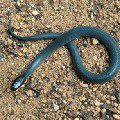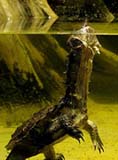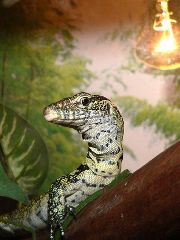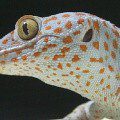
Denison Magnificent
Denison superba (Denisonia superba) is a rare snake whose venom is deadly to humans and animals, like the venom of most aspids, which has a neurotoxic effect. This is not the largest member of the family – only one and a half meters in length – living on the Australian mainland, along with other 19 species of denisons. So this genus can be called endemic to Australia. Denisonia splendid is distinguished by an amazing quality that is not typical for reptiles – live birth. And although people and pets prefer to avoid this snake, it cannot be called overly aggressive, such as, for example, cobras are.
Contents
Classification
Kingdom: Animals
Type: Chord
Subtype: Vertebrates
Class: Reptiles
Order: Scaly
Suborder: Snakes
Family: Asps
Genus: Denison, Denisonia
Species: Denison superb
Appearance
 Denison superb has a fairly well-fed stocky body, slightly flattened above and below. Its external structure is such that the transitions to the head and tail are almost imperceptible, that is, the thickness of the body of the snake is constant almost throughout its entire length and tapers very smoothly towards the tip of the tail and muzzle. The small eyes of the denison with a round pupil are located closer to the top of the head. The coloration of various members of the species can vary from black to dark gray or brown with a copper or reddish tint. Some individuals have a reddish pattern around the head, but in general the snake is solid. Like all aspids, Denison splendid has a pair of poisonous fixed fangs in front, slightly curved back, with a poisonous channel penetrating into them. In the head part, the scales are larger, on the back the skin is smooth, and in the abdominal region the scutes are again enlarged. In this structure of the epidermis, there is a noticeable resemblance to snakes, which is why already-shaped and aspids are often confused with each other. However, denison is also distinguished by a larger and lighter row of scales on the sides of the body. Moreover, representatives of the species living in the lowlands, for some reason, are characterized by a lighter color than the denisons living in the uplands. Perhaps this is due to camouflage, because dark colors predominate among the mountainous rocky landscapes.
Denison superb has a fairly well-fed stocky body, slightly flattened above and below. Its external structure is such that the transitions to the head and tail are almost imperceptible, that is, the thickness of the body of the snake is constant almost throughout its entire length and tapers very smoothly towards the tip of the tail and muzzle. The small eyes of the denison with a round pupil are located closer to the top of the head. The coloration of various members of the species can vary from black to dark gray or brown with a copper or reddish tint. Some individuals have a reddish pattern around the head, but in general the snake is solid. Like all aspids, Denison splendid has a pair of poisonous fixed fangs in front, slightly curved back, with a poisonous channel penetrating into them. In the head part, the scales are larger, on the back the skin is smooth, and in the abdominal region the scutes are again enlarged. In this structure of the epidermis, there is a noticeable resemblance to snakes, which is why already-shaped and aspids are often confused with each other. However, denison is also distinguished by a larger and lighter row of scales on the sides of the body. Moreover, representatives of the species living in the lowlands, for some reason, are characterized by a lighter color than the denisons living in the uplands. Perhaps this is due to camouflage, because dark colors predominate among the mountainous rocky landscapes.
Distribution and habitation
Denison splendid is distributed throughout the southwest of Australia, and is also found in the north of the island of Tasmania. The biotopes she chooses are quite heterogeneous. It can be mountains, valleys, wetlands and even coastal areas. Often denison can be found in lowlands subject to seasonal floods. In general, this snake prefers to settle where there is water nearby. Perhaps the reason for this is the peculiarities of her diet. In addition, denisonia is a magnificent, rather resistant species. She is not afraid of the cold – the longest of all other snakes remains active at the beginning of winter and goes hunting earlier at its end. This snake is a secretive and lonely creature, it likes to hide in dense thickets or stone heaps, where it usually lives.
Behavior and lifestyle
Denison magnificent cannot be called a strictly diurnal reptile. Most often she hunts at night, but sometimes she can forage during the day. Although during the daytime, the snake most often hides in various shelters – cracks in the soil, crevices between stones. Zoologists consider Denison’s venom to be moderately poisonous by Australian standards, but if not treated in time, its bite can lead to death. For the treatment of the bitten, the same antidote is used that neutralizes the poison of the tiger snake.
In hot weather, the magnificent denison comes out of the shelter only at night. However, as a cold-blooded creature, she needs the warmth of external sources – the same ultraviolet or stones heated during the day, on which the snake sometimes basks. Her body is not able to independently regulate body temperature.
Like other aspids, the magnificent denison has strong jaws, since its teeth are designed in such a way that the snake can only pierce prey with them and inject the snake’s venom if they are strongly compressed.
The Denison will only bite as a last resort if it is in danger or has been accidentally stepped on. The rest of the time it is a fairly calm snake, trying not to catch the eye of a person and hunting mainly at night. Sometimes denison magnificent is called a copperhead for a reddish ring around the head. Due to some external resemblance, this snake is sometimes confused with a non-venomous large copper snake that does not live in Australia, or with a copper-headed muzzle, otherwise known as a moccasin snake. Denisonia is also sometimes referred to the related genus of Australian copperhead snakes Austrelaps, and in some sources Denisonia and Austrelaps are synonyms. However, it is still correct to isolate denisonium in a separate genus.
Food
It is no coincidence that the magnificent denison prefers to live near water bodies. Its main food is frogs, tadpoles and some other amphibians. Sometimes a snake can diversify its diet with small reptiles, and sometimes it does not refuse its smaller relatives, but in general cannibalism is not characteristic of it. The inhabitants of the Australian continent do not call the denison “shy” snake for nothing. It is a little aggressive towards the surrounding living world and leads a rather sluggish lifestyle. Presumably, denisons can swim and hunt in the water, although this fact may have arisen in their scientific biography as another mistake due to the similarity with some species of Australian water snakes. So it’s definitely not proven.
Reproduction
 Perhaps the most interesting area for zoologists is the reproduction of denison superb. Nature endowed this snake with a semblance of a placenta, with the help of which the circulatory systems of the embryos and the mother are connected. The incubation of the embryos occurs, respectively, in the body of the snake, and completely independent living snakes are born. This method of reproduction should be distinguished from ovoviviparity, when the embryos in the mother’s body are in the egg shells, and there is no question of any connection of the vessels. In denison, things are a little different, yet it has the rudiments of a true live birth.
Perhaps the most interesting area for zoologists is the reproduction of denison superb. Nature endowed this snake with a semblance of a placenta, with the help of which the circulatory systems of the embryos and the mother are connected. The incubation of the embryos occurs, respectively, in the body of the snake, and completely independent living snakes are born. This method of reproduction should be distinguished from ovoviviparity, when the embryos in the mother’s body are in the egg shells, and there is no question of any connection of the vessels. In denison, things are a little different, yet it has the rudiments of a true live birth.
Viviparous species of snakes are not characterized by caring for offspring. By itself, this method of reproduction is already a protection against predators and at the same time a mobile incubator. Live born offspring are much more likely to survive in the wild without parental support. Babies come into the world already poisonous and able to defend themselves. Not much is known about the reproduction of denison magnificent, since the terrarium keeping of poisonous snakes presents certain difficulties. Yes, and viviparous species in captivity often stop breeding, so zoologists have not yet been able to track this process, in the case of denison, in detail.
It is assumed that the mating season for magnificent denisons begins in the spring, and the cubs appear at the end of summer. Their number can be up to 40 pieces. Such fertility is another opportunity for successful procreation. Some of the numerous brood will still reach maturity.
Sources of
http://www.biodat.ru
http://en.wikipedia.org
http://www.zmeuga.ru
http://www.id4.ru/





